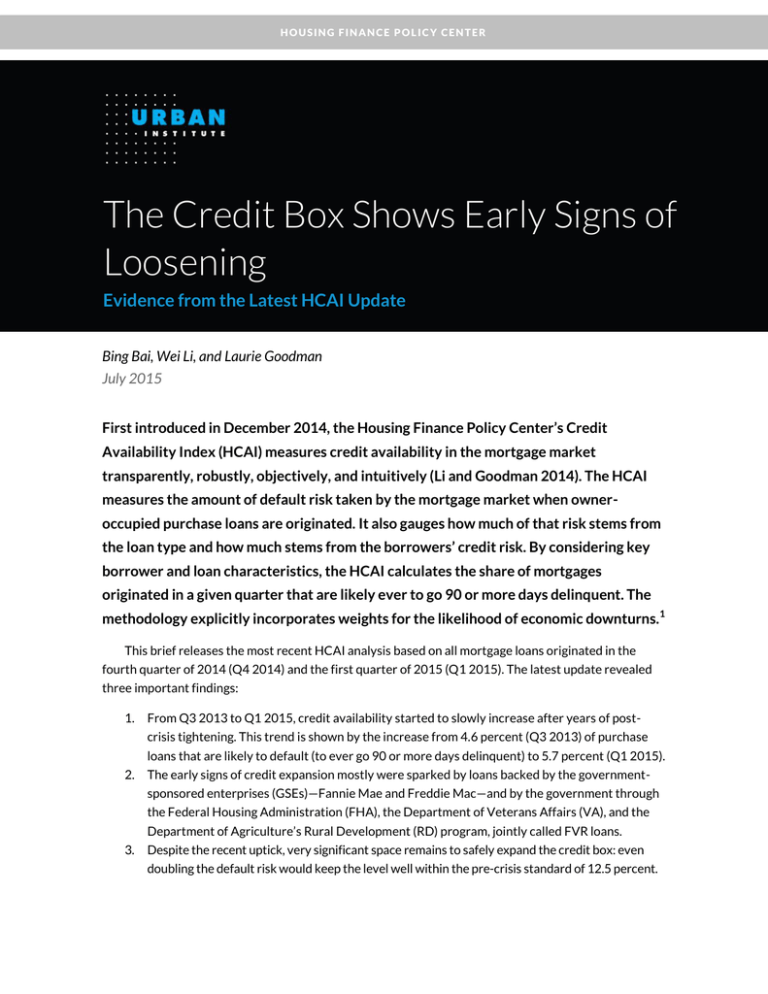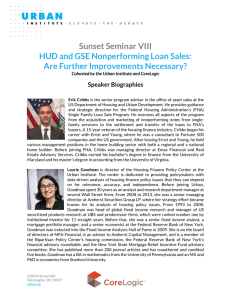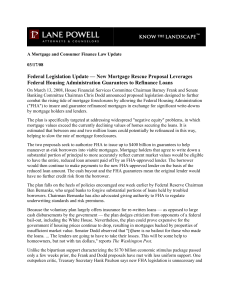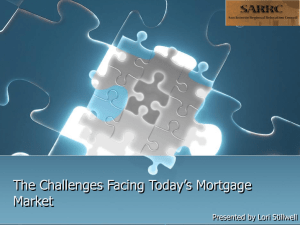The Credit Box Shows Early Signs of Loosening
advertisement

HOUSING FINANCE POLICY CENTER The Credit Box Shows Early Signs of Loosening Evidence from the Latest HCAI Update Bing Bai, Wei Li, and Laurie Goodman July 2015 First introduced in December 2014, the Housing Finance Policy Center’s Credit Availability Index (HCAI) measures credit availability in the mortgage market transparently, robustly, objectively, and intuitively (Li and Goodman 2014). The HCAI measures the amount of default risk taken by the mortgage market when owneroccupied purchase loans are originated. It also gauges how much of that risk stems from the loan type and how much stems from the borrowers’ credit risk. By considering key borrower and loan characteristics, the HCAI calculates the share of mortgages originated in a given quarter that are likely ever to go 90 or more days delinquent. The methodology explicitly incorporates weights for the likelihood of economic downturns.1 This brief releases the most recent HCAI analysis based on all mortgage loans originated in the fourth quarter of 2014 (Q4 2014) and the first quarter of 2015 (Q1 2015). The latest update revealed three important findings: 1. From Q3 2013 to Q1 2015, credit availability started to slowly increase after years of postcrisis tightening. This trend is shown by the increase from 4.6 percent (Q3 2013) of purchase loans that are likely to default (to ever go 90 or more days delinquent) to 5.7 percent (Q1 2015). 2. The early signs of credit expansion mostly were sparked by loans backed by the governmentsponsored enterprises (GSEs)—Fannie Mae and Freddie Mac—and by the government through the Federal Housing Administration (FHA), the Department of Veterans Affairs (VA), and the Department of Agriculture’s Rural Development (RD) program, jointly called FVR loans. 3. Despite the recent uptick, very significant space remains to safely expand the credit box: even doubling the default risk would keep the level well within the pre-crisis standard of 12.5 percent. We first examine the latest HCAI trends both for the market as a whole and for different market segments. We then compare HCAI results with median borrowers’ credit score at origination. Finally, we discuss the steps taken by the GSEs and FHA to improve lender clarity—actions that may explain the recent small uptick in credit availability. HCAI for the Whole Market The HCAI trends depicted in figure 1 show that the mortgage default risk the market is willing to take peaked from 2005 to 2007, mostly fueled by the popularity of risky loan products during the height of the housing bubble. In the aftermath of the crisis, the market eliminated almost all risky products and implemented more restrictive borrower credit standards. The total expected default risk taken by the market dropped to its lowest level, 4.6 percent, in Q3 2013. Since then, access to credit has started to increase slowly, reaching 5.7 percent by Q1 2015. FIGURE 1 HCAI: Default Risk Taken by the Mortgage Market over Time Sources: CoreLogic, Home Mortgage Disclosure Data (HMDA), and Urban Institute. Note: Total default risk is based on borrower characteristics plus riskiness of loan product. 2 THE CREDIT BOX SHOWS EARLY SIGNS OF LOOSENING The default risk measured by the HCAI varies from quarter to quarter, but when the data are aggregated by groups of years, the pattern becomes very clear (figure 2). Using the same assumptions about economic conditions, we see that 5.5 percent of loans taken out to purchase an owner-occupied home from Q1 2014 through Q1 2015 were likely to default, slightly up from 5 percent of loans originated in 2013. The higher percentage indicates a small increase in credit access. However, much room still remains to safely expand the credit box. In 2001–03, a prebubble period of more balanced and standard credit access, the market allowed a total of 12.5 percent credit risk, of which 9.1 percent stemmed from borrower credit risk and 3.4 percent from product risk. Given the absence of risky products in today’s market, even doubling the most recent 5.5 percent default risk would keep the risk well within the 2001–03 standard. FIGURE 2 Default Risk Taken by the Mortgage Market over Time, by Year or Years Sources: CoreLogic, HMDA, and Urban Institute. THE CREDIT BOX SHOWS EARLY SIGNS OF LOOSENING 3 HCAI by Channels The HCAI methodology allows us to measure credit availability by expected default risk for three separate mortgage origination channels: government loans (FVR), GSE loans, and portfolio and privatelabel security (PP) loans. Government Loans (FVR) Following a pattern similar to the market as a whole, the total default risk the government loan channel is willing to take bottomed out at 9.6 percent in Q3 2013, then began to climb steadily to 10.8 percent by Q1 2015. The product risk also ticked up from 0.1 percent to 0.3 percent over the same period because of slightly more, although still very limited, use of adjustable-rate mortgages with shorter periods before the initial rate reset. Even the most recent credit risk for the government channel, however, is just under half the prebubble level (21.6 percent from 2001 to 2003; see figure 3). FIGURE 3 Default Risk Taken by the Government Channel (FHA, VA, and RD) Sources: CoreLogic, HMDA, and Urban Institute. 4 THE CREDIT BOX SHOWS EARLY SIGNS OF LOOSENING GSE Loans Like its FVR counterpart, the GSE market made some progress in expanding the credit box for borrowers in recent years (figure 4). In the GSE channel, the downward trend of credit availability was reversed in Q2 2011. From Q3 2013 to Q1 2015, a period during which both channels provided more access to credit, the total risk taken by the GSE channel increased 17 percent (1.8 percent to 2.1 percent), compared with 12.5 percent for the FVR channel (9.6 percent to 10.8 percent). FIGURE 4 Default Risk Taken by the GSE Channel Sources: CoreLogic, HMDA, and Urban Institute. The current GSE total expected default risk level of 2.1 percent is only slightly more than one-third of the 2001–03 level (5.6 percent). This level leaves much room to expand the credit box, even after four years of slow progress. THE CREDIT BOX SHOWS EARLY SIGNS OF LOOSENING 5 PP Loans The PP channel took much higher product risk than did the FVR and GSE channels during the bubble. After the crisis, both product and borrower risks dropped sharply; they have stabilized since 2013. Recently, product risk has fluctuated around 0.6 percent and borrower risk around 2 percent (figure 5). FIGURE 5 Default Risk Taken by the Portfolio and Private-Label Securities Channel Sources: CoreLogic, HMDA, and Urban Institute. Median Borrower Credit Score at Origination The HCAI’s finding of a slight loosening of the credit box since 2013 is consistent with trends in 2 borrower median credit scores at origination, as shown in figure 6. The median credit scores for both GSE and government loans have been on a steady decline since 2013. As of May 2015, the median credit score for GSE loans stood at 758, down from 769 for the same month two years ago. The government market experienced a similar drop, from 691 to 682 in the past two years. 6 THE CREDIT BOX SHOWS EARLY SIGNS OF LOOSENING FIGURE 6 Borrowers’ Median Credit Score at Origination: Government and GSE Loans Sources: CoreLogic, eMBS, and Urban Institute. Pooling GSE and government loans reveals that the median credit score of the combined markets remained largely unchanged during 2013. The credit score for both GSE and government loans declined because borrowers with higher FICO scores chose GSE lending over FHA lending—thus shifting the 3 market share and reducing the credit scores of both. When such a shift occurs, a median credit score could be a misleading indicator of credit availability. Since 2014, the median credit score of the combined markets began to drop steadily from 729 in January 2014 to 722 in May 2015, ruling out the market compositional change and indicating credit easing in both markets. GSEs’ and FHA’s Efforts to Open Up the Credit Box 4 GSE and FHA lending dominates the postcrisis mortgage market. Today’s tight credit box is largely the result of lender reluctance to lend to the full extent of credit box allowed by the GSEs and the FHA. One key reason has been deep uncertainty about when and why those entities will force lenders to take back the credit risk that they thought they were transferring to the GSEs and FHA, otherwise known as the put-back risk. For the past two and half years, the GSEs and their conservator, the Federal Housing Finance Agency (FHFA), have taken several steps to clarify the standards for mortgage put-backs, including the introduction of reps and warrants sunsets in 2012 and the relaxation of the sunset eligibility requirement and clarifications of life-of-loan exclusions in 2014. The GSEs also have been doing more due diligence to evaluate the quality of lender underwriting shortly after loan purchase; in some cases, THE CREDIT BOX SHOWS EARLY SIGNS OF LOOSENING 7 they have been giving lenders some feedback before purchase—when the lender can often correct mistakes. These policies have led to significant progress in lender clarity (Goodman, Parrott and Zhu 2015). And this has begun to open up the credit box in GSE lending, as shown in figure 4. The FHA has lagged the GSEs and the FHFA in its efforts to reduce lender uncertainty. As first steps to give lenders more clarity and transparency, the FHA published the FHA Single Family Housing Policy Handbook in March 2015 and the FHA defect taxonomy in June 2015. Although the handbook is a big step forward, putting together more than 900 mortgagee letters issued over time, it still suffers from some inconsistencies (FHA 2015a). Adopting the taxonomy, which outlines the various errors and establishes a classification scheme for them, was also a major step forward (FHA 2015b). However, the taxonomy does not provide remedies for each error type, and it provides no assurance for lenders that FHA actions will in fact rely on the taxonomy. FHA lenders also face several other obstacles to expanding the credit box: the higher cost of servicing delinquent loans (Goodman 2014) compared with the cost of servicing GSE loans, as well as the significant and uncertain litigation risk associated with defaulted loans under the False Claims Act (Goodman 2015). The latter could be helped with relatively modest changes to the certification that lenders sign concerning each loan they submit to the FHA. Conclusion Although credit was too lax during the housing bubble years, the pendulum has swung too far in the other direction. The latest update of the HCAI shows that credit availability has started to slowly increase after years of postcrisis credit tightening. In Q1 2015, the market was willing to take 5.7 percent of expected default risk, up slightly from the trough level of 4.6 percent in Q3 2013. The credit expansion was driven by less restrictive lending in the GSE and government markets, partly as a result of recent efforts by the GSEs, FHFA, and FHA to reduce lender uncertainty. Although small progress has been made, significant room remains to safely expand the credit box. The mortgage market could have taken twice the default risk it took in the first quarter of 2015 and still have remained well within the cautious standard of 2001–03. 8 THE CREDIT BOX SHOWS EARLY SIGNS OF LOOSENING Notes 1. For details of HCAI calculations and data sources, see Laurie Goodman Wei Li, “New Credit Availability Measure Shows Product Risk, Not Borrower Risk, Fueled the Housing Crisis,” Urban Wire (blog, Urban Institute), December 9, 2014, http://www.urban.org/urban-wire/new-credit-availability-measure-showsproduct-risk-not-borrower-risk-fueled-housing-crisis. 2. The HCAI is a more comprehensive measure of credit availability than is the median borrowers’ credit score because it also accounts for loan-to-value, debt-to-income, and other key borrower and loan characteristics that help lenders determine the risk level of a particular loan. 3. Bing Bai, Jun Zhu, and Laurie Goodman, “Is Mortgage Credit Finally Starting to Loosen? Afraid Not,” Urban Wire (blog, Urban Institute), May 2, 2014, http://www.urban.org/urban-wire/mortgage-credit-finally-startingloosen-afraid-not. 4. See figure 2 of Bai, Zhu and Goodman (2015) for the purchase mortgage market composition over time. References Bai, Bing, Jun Zhu, and Laurie Goodman. 2015. “A Closer Look at the Data on First-Time Homebuyers.” Washington, DC: Urban Institute. http://www.urban.org/research/publication/closer-look-data-first-timehomebuyers. FHA (Federal Housing Administration). 2015a. FHA Single Family Housing Policy Handbook. Washington, DC: FHA. ———. 2015b. FHA’s Single Family Housing Loan Quality Assessment Methodology. Washington, DC: FHA. Goodman, Laurie. 2014. “Servicing Is an Underappreciated Constraint on Credit Access.” Washington, DC: Urban Institute. http://www.urban.org/research/publication/servicing-underappreciated-constraint-credit-access. ———. 2015. “Wielding a Heavy Enforcement Hammer Has Unintended Consequences for the FHA Mortgage Market.” Washington, DC: Urban Institute. http://www.urban.org/research/publication/wielding-heavyenforcement-hammer-has-unintended-consequences-fha-mortgage-market. Goodman, Laurie, Jim Parrott, and Jun Zhu. 2015. “The Impact of Early Efforts to Clarify Mortgage Repurchases: Evidence from Freddie Mac and Fannie Mae’s Newest Data.” Washington, DC: Urban Institute. http://www.urban.org/research/publication/impact-early-efforts-clarify-mortgage-repurchases. Li, Wei, and Laurie Goodman. 2014. “Measuring Mortgage Credit Availability Using Ex-Ante Probability of Default.” Washington, DC: Urban Institute. http://www.urban.org/research/publication/measuring-mortgage-creditavailability-using-ex-ante-probability-default. THE CREDIT BOX SHOWS EARLY SIGNS OF LOOSENING 9 About the Authors Bing Bai is a research associate with the Housing Finance Policy Center at the Urban Institute, where he helps build, manage, and explore data to analyze housing finance trends and related policy issues. Formerly an economic modeling senior at Freddie Mac, Bai conducted research on housing and mortgage markets and developed models to evaluate foreclosure alternatives for nonperforming mortgage loans. He holds a PhD in economics from Clemson University. Wei Li is a senior research associate in the Housing Finance Policy Center at the Urban Institute, where his research focuses on the social and political aspects of the housing finance market and their implications for urban policy. He is also a quantitative research methodologist with a deep understanding of cost–benefit analysis, program evaluation, and causal inference in social and political science. Before joining Urban, Li was a principal researcher with the Center for Responsible Lending, where he wrote numerous publications on the housing finance market and created and managed the nonprofit organization’s comprehensive residential mortgage database. Li’s work has been published widely in various academic journals and has been covered in the Wall Street Journal, Washington Post, and New York Times as well as in other print and broadcast media. Li received his PhD in environmental science, policy, and management and an MA in statistics from the University of California at Berkeley. Laurie Goodman is the director of the Housing Finance Policy Center at the Urban Institute. The center is dedicated to providing policymakers data-driven analyses of housing finance policy issues that they can depend on for relevance, accuracy, and independence. Before joining Urban in 2013, Goodman spent 30 years as an analyst and research department manager at a number of Wall Street firms. From 2008 to 2013, she was a senior managing director at Amherst Securities Group, LP, a boutique broker/dealer specializing in securitized products, where her strategy effort became known for its analysis of housing policy issues. From 1993 to 2008, Goodman was head of global fixed income research and manager of US securitized products research at UBS and predecessor firms, which were ranked first by Institutional Investor for 11 straight years. Before that, she was a senior fixed income analyst, a mortgage portfolio manager, and a senior economist at the Federal Reserve Bank of New York. Goodman was inducted into the Fixed Income Analysts Hall of Fame in 2009. She serves on the board of directors of MFA Financial and is a member of the Bipartisan Policy Center’s Housing Commission, the Federal Reserve Bank of New York’s Financial Advisory Roundtable, and the New York State Mortgage Relief Incentive Fund Advisory Committee. She has published more than 200 journal articles and has coauthored and coedited five books. Goodman has a BA in mathematics from the University of Pennsylvania and an MA and PhD in economics from Stanford University. 10 THE CREDIT BOX SHOWS EARLY SIGNS OF LOOSENING Acknowledgments The Urban Institute’s Housing Finance Policy Center (HFPC) was launched with generous support at the leadership level from the Citi Foundation and the John D. and Catherine T. MacArthur Foundation. Additional support was provided by the Ford Foundation and the Open Society Foundations. Ongoing support for HFPC is also provided by the Housing Finance Council, a group of firms and individuals supporting high-quality independent research that informs evidence-based policy development. Funds raised through the Housing Finance Council provide flexible resources, allowing HFPC to anticipate and respond to emerging policy issues with timely analysis. This funding supports HFPC’s research, outreach and engagement, and general operating activities. This brief was funded by these combined sources. We are grateful to them and to all our funders, who make it possible for Urban to advance its mission. Funders do not, however, determine our research findings or the insights and recommendations of our experts. The views expressed are those of the authors and should not be attributed to the Urban Institute, its trustees, or its funders. ABOUT THE URBAN INST ITUTE 2100 M Street NW Washington, DC 20037 www.urban.org The nonprofit Urban Institute is dedicated to elevating the debate on social and economic policy. For nearly five decades, Urban scholars have conducted research and offered evidence-based solutions that improve lives and strengthen communities across a rapidly urbanizing world. Their objective research helps expand opportunities for all, reduce hardship among the most vulnerable, and strengthen the effectiveness of the public sector. Copyright © July 2015. Urban Institute. Permission is granted for reproduction of this file, with attribution to the Urban Institute. THE CREDIT BOX SHOWS EARLY SIGNS OF LOOSENING 11




